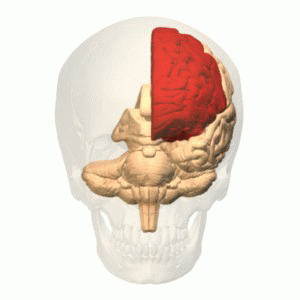Frontal Lobe Brain Injury: Difference between revisions
Wendy Walker (talk | contribs) No edit summary |
Wendy Walker (talk | contribs) No edit summary |
||
| Line 6: | Line 6: | ||
== Introduction == | == Introduction == | ||
In evolutionary terms the frontal cortex has been the most recent to evolve, and the frontal lobes are the area of brain which has developed greatly in humans, differentiating us from other mammals. These lobes integrate the other brain areas, and are particularly responsible for higher level thinking and cognitive skills such as planning, evaluating likely outcomes, multitasking, performing risk assessment and the niceties of social interaction; it is the area of brain which deals in abstract concepts. | In evolutionary terms the frontal cortex has been the most recent to evolve, and the frontal lobes are the area of brain which has developed greatly in humans, differentiating us from other mammals. These lobes integrate the other brain areas, and are particularly responsible for higher level thinking and cognitive skills such as planning, evaluating likely outcomes, multitasking, performing risk assessment and the niceties of social interaction; it is the area of brain which deals in abstract concepts. | ||
== Anatomy<br> == | == Anatomy<br> == | ||
| Line 12: | Line 12: | ||
The Frontal Lobes account for approximately one third of human brain mass. | The Frontal Lobes account for approximately one third of human brain mass. | ||
[[Image: | [[Image:Frontal lobe animation.gif|right|300px]]They lie at the front of the brain, anterior to the parietal lobes and superior to the temporal lobe. | ||
Each frontal lobe (left and right) is generally considered to have 4 distinct divisions: | Each frontal lobe (left and right) is generally considered to have 4 distinct divisions: | ||
| Line 23: | Line 23: | ||
== Function<br> == | == Function<br> == | ||
Author Mesulam suggests that the frontal lobe is the part of the brain which modifies and imposes constraints on reflexive behaviours<ref>The Human Frontal Lobes: Transcending the Default Mode through Continent Encoding. Mesulam MM. DT Stuss and RT Knight. Principles of Frontal Lobe Function. Oxford: 2002. 8-30</ref>, and this control develops as the infant brain grows<ref>Handbook of developmental cognitive neuroscience. Luciana, ed. by Charles A. Nelson; Monica (2001). Cambridge, Mass. [u.a.]: MIT Press.</ref> and the frontal lobes become larger and more active. | Author Mesulam suggests that the frontal lobe is the part of the brain which modifies and imposes constraints on reflexive behaviours<ref>The Human Frontal Lobes: Transcending the Default Mode through Continent Encoding. Mesulam MM. DT Stuss and RT Knight. Principles of Frontal Lobe Function. Oxford: 2002. 8-30</ref>, and this control develops as the infant brain grows<ref>Handbook of developmental cognitive neuroscience. Luciana, ed. by Charles A. Nelson; Monica (2001). Cambridge, Mass. [u.a.]: MIT Press.</ref> and the frontal lobes become larger and more active. | ||
== Pathology/Injury<br> == | == Pathology/Injury<br> == | ||
Revision as of 23:51, 19 June 2016
Original Editor - Your name will be added here if you created the original content for this page.
Lead Editors - Wendy Walker, Lucinda hampton, Aminat Abolade, Kim Jackson, WikiSysop and Claire Knott
Introduction[edit | edit source]
In evolutionary terms the frontal cortex has been the most recent to evolve, and the frontal lobes are the area of brain which has developed greatly in humans, differentiating us from other mammals. These lobes integrate the other brain areas, and are particularly responsible for higher level thinking and cognitive skills such as planning, evaluating likely outcomes, multitasking, performing risk assessment and the niceties of social interaction; it is the area of brain which deals in abstract concepts.
Anatomy
[edit | edit source]
The Frontal Lobes account for approximately one third of human brain mass.
They lie at the front of the brain, anterior to the parietal lobes and superior to the temporal lobe.
Each frontal lobe (left and right) is generally considered to have 4 distinct divisions:
- Motor and premotor cortex
- Prefrontal cortex
- Orbital [AKA orbitofrontal) cortex
- Broca's Area
Function
[edit | edit source]
Author Mesulam suggests that the frontal lobe is the part of the brain which modifies and imposes constraints on reflexive behaviours[1], and this control develops as the infant brain grows[2] and the frontal lobes become larger and more active.
Pathology/Injury
[edit | edit source]
It has been found that in traumatic brain injury contusions typically occur on the poles and the inferior aspects of the frontal lobes[3].
Resources[edit | edit source]
Recent Related Research (from Pubmed)[edit | edit source]
Extension:RSS -- Error: Not a valid URL: Feed goes here!!|charset=UTF-8|short|max=10
References[edit | edit source]
References will automatically be added here, see adding references tutorial.
- ↑ The Human Frontal Lobes: Transcending the Default Mode through Continent Encoding. Mesulam MM. DT Stuss and RT Knight. Principles of Frontal Lobe Function. Oxford: 2002. 8-30
- ↑ Handbook of developmental cognitive neuroscience. Luciana, ed. by Charles A. Nelson; Monica (2001). Cambridge, Mass. [u.a.]: MIT Press.
- ↑ Post-operative expansion of hemorrhagic contusions after unilateral decompressive hemicraniectomy in severe traumatic brain injury. Flint AC, Manley GT, Gean AD, et al. J Neurotrauma. Mar 17 2008







